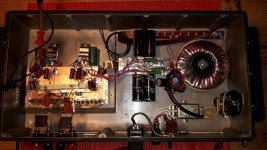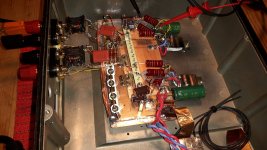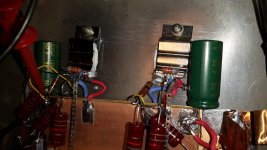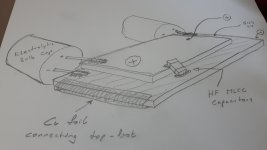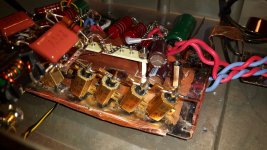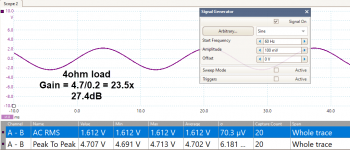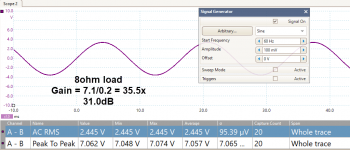Here is my take on a mixed feedback chip amp.
Reason for creation: I need a bass amp for my OB speakers. Fullrange Wild Burros are driven by my beloved 4W flea amp (tube). The 15" woofer needs help... Attenuating the FR 6dB actually gives a great speaker just using the tube amp, even at movie levels. But you know...
Why mixed feedback... OB speakers need high Qts speakers. I may be misinformed, but I think having resistance in series w/woofer increases the combination Qts. Besides, a current feedback amp will have greater gain into high Z, and the 35Hz resonance of the woofer will then get more voltage over itself giving more low end... In my thinking...
Why not 100% current feedback? Why mixed... Well, I don't want to over do it. The resonance at fs creates a rather high Z, and in simulations I see the gain rising scary high, and I don't want the amp to run into it's rails.
This worked out pretty well. Done over the weekend, using some Cu print boards as GND, V+, and V- rails. The GND plane is good for freely placing components without worrying about return paths. Or put another way, ensuring lowest possible inductance in the signal loops.
Having built enough point to point tube amps, I figure no need for circuit board in such a simple circuit as this. I am too lazy to spend days designing the layout and having to wait for the prints to arrive...
I only had a transformer providing +-15V, so the power is not as much as what theses chips are good for. But next to my 4W tube amp, it'll just do.
20W into 4ohms and 12W into 8ohm. (Approximately, I never bother measuring this precisely because I cannot hear the difference in +-1or2dB anyways)
The final result is quite satisfying, even going full range and replacing my tube amp as I do some mods to it.
Reason for creation: I need a bass amp for my OB speakers. Fullrange Wild Burros are driven by my beloved 4W flea amp (tube). The 15" woofer needs help... Attenuating the FR 6dB actually gives a great speaker just using the tube amp, even at movie levels. But you know...
Why mixed feedback... OB speakers need high Qts speakers. I may be misinformed, but I think having resistance in series w/woofer increases the combination Qts. Besides, a current feedback amp will have greater gain into high Z, and the 35Hz resonance of the woofer will then get more voltage over itself giving more low end... In my thinking...
Why not 100% current feedback? Why mixed... Well, I don't want to over do it. The resonance at fs creates a rather high Z, and in simulations I see the gain rising scary high, and I don't want the amp to run into it's rails.
This worked out pretty well. Done over the weekend, using some Cu print boards as GND, V+, and V- rails. The GND plane is good for freely placing components without worrying about return paths. Or put another way, ensuring lowest possible inductance in the signal loops.
Having built enough point to point tube amps, I figure no need for circuit board in such a simple circuit as this. I am too lazy to spend days designing the layout and having to wait for the prints to arrive...
I only had a transformer providing +-15V, so the power is not as much as what theses chips are good for. But next to my 4W tube amp, it'll just do.
20W into 4ohms and 12W into 8ohm. (Approximately, I never bother measuring this precisely because I cannot hear the difference in +-1or2dB anyways)
The final result is quite satisfying, even going full range and replacing my tube amp as I do some mods to it.
Attachments
Last edited:
Some measurements.
Edit: Note the lower perceived distortions as the power is increased. As if at 1W, the artifacts of SS are playing a relative bigger part in the mix. The best performance is just before clipping, and 4ohm load is 'better' than 8ohm.
Exact opposite a tube amp characteristic.
Edit: Note the lower perceived distortions as the power is increased. As if at 1W, the artifacts of SS are playing a relative bigger part in the mix. The best performance is just before clipping, and 4ohm load is 'better' than 8ohm.
Exact opposite a tube amp characteristic.
Attachments
Last edited:
Oh, I forgot...
So instead of resistor in series with woofer, for higher Qts, a current feedback amp should act the same, but without the losses a resistor creates..
Also, b/c of the mixed feedback, the input resistance is low, matching the feedback resistance, this for low offset, which is very low...
The amp must be driven by a pre that can handle the low input impedance.
I intend to drive this from the other tube amp, with a passive 4th order LPF in between. I need the attenuation anyways, so for my use the low input resistance is not a problem.
So instead of resistor in series with woofer, for higher Qts, a current feedback amp should act the same, but without the losses a resistor creates..
Also, b/c of the mixed feedback, the input resistance is low, matching the feedback resistance, this for low offset, which is very low...
The amp must be driven by a pre that can handle the low input impedance.
I intend to drive this from the other tube amp, with a passive 4th order LPF in between. I need the attenuation anyways, so for my use the low input resistance is not a problem.
Looks good, didn´t do the detailed Math but you have about a damping factor of 1 or near enough.
A good sensible value to improve some characteristics, specifically Bass around resonance and high frequencies ... what some call "Tube Sound" he he and are not much mistaken.
Full current drive would be too much and make that speaker give the dreaded "one note Bass" from the 40´s and early 50´s, typical of Rockolas and such.
A good sensible value to improve some characteristics, specifically Bass around resonance and high frequencies ... what some call "Tube Sound" he he and are not much mistaken.
Full current drive would be too much and make that speaker give the dreaded "one note Bass" from the 40´s and early 50´s, typical of Rockolas and such.
